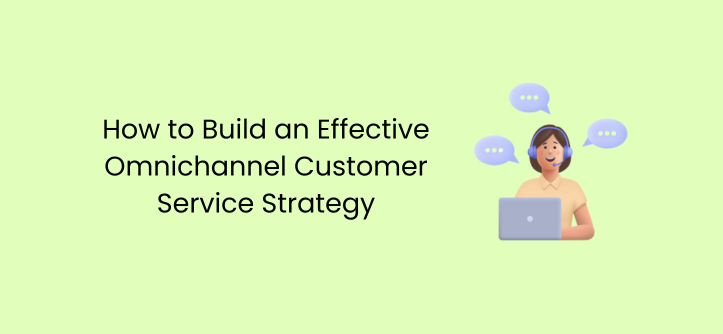
Damilola Oyetunji
Content Writer at Chatway.
Quickly respond to customer and visitor inquiries via live chat
Personalize the chat widget to match your business's style and branding
Stay updated on all incoming messages with email and push notifications
Improve the way your team works with chat assignments and private notes
Provide support on the go with Chatway's mobile apps for iOS and Android devices
Categorize and label conversations using specific criteria for personalized support
Interact with visitors in their preferred language, supporting 20+ languages
Use Chatway live chat on multiple platforms such as Shopify, Wix, Duda etc
Get insights into your support activities to better understand customer interactions
Centralize chats from Messenger and email into a single dashboard
All,Customer Service,E-Commerce,Marketing,Support - 7 Mins READ
Content Marketer

Are you struggling to provide a seamless and consistent customer experience across all your communication channels? Do your customers feel frustrated by having to repeat their issues every time they contact you through a different channel?
If you answered yes to these questions, then you need an effective omnichannel customer service strategy. Customers today, expect to interact with businesses through various channels, including social media, email, live chat, phone, and in-person.
Building an omnichannel customer service strategy can help you deliver a unified and personalized experience to your customers, regardless of how they choose to communicate with you.
In this piece, we’ll provide you with actionable tips to help you build an effective omnichannel customer service strategy that can drive customer satisfaction, loyalty, and revenue. Before we dive into the details of how to build an effective omnichannel customer service strategy, let’s define what it means.
An omnichannel customer service is a holistic approach to customer support that enables customers to interact with a business through any channel they choose, seamlessly transitioning from one channel to another without having to start the conversation over.
It involves integrating all your communication channels into a unified system that provides consistent and personalized support to your customers.
An effective omnichannel customer service strategy involves more than just adding more communication channels to your existing support channels. It requires a complete overhaul of your customer support infrastructure and a shift in mindset from a channel-centric to a customer-centric approach. By putting the customer at the center of your strategy, you can create a seamless and consistent experience that meets their needs and expectations, regardless of the channel they choose to use.

Image source: Freepik
So, why is an effective omnichannel customer service strategy important?
The answer is simple – customers expect it. According to a survey by Salesforce, 80% of customers say that the experience a company provides is as important as its products or services. Furthermore, customers who have a positive experience with a company are more likely to become repeat customers and advocates for the brand.
While you may want to offer support through every possible channel, it’s important to keep in mind that not all channels may be relevant or effective for your business. What then should you consider when choosing channels for your omnichannel strategy?
Understanding your customers’ preferences and behaviours is key to choosing the right channels for your omnichannel strategy. For example, if your customers are primarily millennials or Gen Z, they may prefer to interact with your brand through social media channels such as Instagram or Twitter. On the other hand, if your customers are primarily baby boomers or Gen X, they may prefer to use email or phone.
Consider the channels that are currently available to you and the resources you have to manage them effectively. For example, if you don’t have the resources to manage a chatbot, it may not be a good idea to include it as a support channel.

Image source: Freepik
Evaluate the effectiveness of each channel in addressing different types of customer issues. For example, email may be better suited for handling complex issues that require detailed explanations, while chat or phone may be more effective for handling urgent issues that require immediate attention.
Ensure that all your channels are integrated and connected to provide a seamless experience for your customers. This means that a customer should be able to start a conversation on one channel and seamlessly switch to another without having to repeat their issue.
Use analytics to track the performance of each channel and make data-driven decisions to optimize your omnichannel strategy over time.
Before building an omnichannel customer service strategy, it’s important to define your objectives and goals. Ask yourself what you want to achieve with your customer service strategy. This will help you stay focused and measure your success. Examples of objectives could include increasing customer satisfaction, reducing response time, or improving first-contact resolution.
To provide a great customer service experience, you need to understand your customers’ needs and preferences. This means researching your target audience and identifying their pain points, expectations, and preferred communication channels. You can use surveys, focus groups, or customer feedback to gather this information.
Once you know your customer’s preferences, you can choose the right communication channels to meet their needs. This could include phone, email, live chat, social media, or self-service options. It’s important to offer a variety of channels to give your customers the flexibility to choose the one that works best for them.
To provide a seamless customer service experience, it’s important to integrate your channels. This means allowing customers to switch between channels without having to repeat information or start over. For example, if a customer starts a conversation on social media, they should be able to continue it on the phone or email without having to repeat themselves.
Investing in technology and automation can help you provide faster and more efficient customer service. This could include chatbots, AI-powered tools, or self-service options. However, it’s important to balance automation with human interaction to ensure a personalized experience.
A CRM system can help you manage customer interactions and data across multiple channels. This can help you provide a more personalized and efficient service. Make sure your CRM system is integrated with your communication channels for a seamless experience.
Your customer service team is the face of your brand, so it’s important to train them properly. They should be knowledgeable about your products or services, have good communication skills, and be able to handle difficult situations. Make sure they understand the importance of providing a consistent and personalized customer service experience across all channels.
Training should be an ongoing process to ensure your team stays up to date with new products, services, or technology. Providing coaching and feedback can also help them improve their skills and provide a better customer service experience. Make sure to provide regular training and coaching to your team to help them stay motivated and engaged.
A knowledge base can provide customers with quick and easy answers to their questions without having to contact your customer service team. This can help reduce wait times and improve customer satisfaction. Make sure to keep your knowledge base up to date with the latest information and make it easily accessible to your customers.
Monitoring and analyzing customer feedback can help you identify areas for improvement and measure your success. Make sure to collect feedback from all channels and analyze it regularly to identify patterns or trends. This can help you make informed decisions about how to improve your customer service strategy.
In addition to analyzing feedback, it’s important to gather customer insights and feedback proactively. This could include conducting surveys, focus groups, or user testing to identify pain points or areas for improvement. Use this feedback to inform your customer service strategy and make data-driven decisions.
Your customer service strategy should be an ongoing process of improvement. Use the feedback and insights you gather to make changes and updates to your strategy as needed. Continuously measure your success and ROI and adjust your strategy accordingly.

Image source: Freepik
Social media is an important channel for customer service, as many customers prefer to reach out to brands on social media. Make sure to have a dedicated social media team that can respond to customer inquiries in a timely and professional manner. Use social media monitoring tools to track conversations and respond to customers quickly.
Encouraging customer feedback and engagement can help improve your customer service strategy and build customer loyalty. This could include asking for feedback after a customer service interaction, offering rewards or incentives for feedback, or creating a customer advisory board to gather insights and feedback.
Measuring your success and ROI is important to ensure that your customer service strategy is effective and delivering results. Use metrics such as customer satisfaction, response time, and first contact resolution to measure your success. Calculate your ROI by comparing the cost of your customer service strategy to the revenue generated by happy customers.
Building an effective omnichannel customer service strategy is crucial for businesses that want to improve customer satisfaction and loyalty. Defining your objectives and goals, understanding your customers’ needs and preferences, choosing the right communication channels, investing in technology and automation, and continuously improving your strategy, are all strategies that you must employ to provide a seamless and personalized customer service experience across all channels. Don’t forget to measure your success and ROI to ensure that your strategy is delivering results.

Content Writer at Chatway.

Content Writer at Chatway.

Content Writer at Chatway.